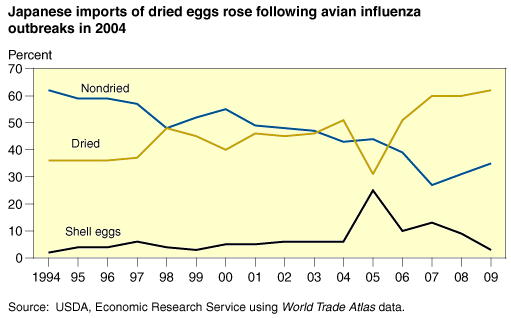



Avian Influenza Boosted Japan’s Imports of Dried Egg Products
An outbreak of bird flu in Japan in 2004 provided the first evidence that consumers choose egg products over shell eggs on the grounds of food safety, according to Fawzi Taha and William Hahn of the USDA Economic Research Service (ERS) in the latest issue of Amber Waves.Animal disease outbreaks can have major trade impacts. ERS analysis of the effects of the 2004 outbreak of highly pathogenic avian influenza (HPAI) H5N1-virus in Japan showed evidence of a willingness of Japanese consumers to substitute – for food safety reasons – processed dried egg products for fresh shell eggs. These changes in preference affect US exports of shell eggs and egg products.

ERS researchers divided Japan’s egg imports into shell eggs, non-dried egg products and dried egg products. Fresh eggs are the most likely to carry the virus on the shell surface as well as inside, while dried egg products are produced through heating that kills the virus.
Data on Japan’s egg imports following the outbreak showed a change in demand in shell eggs and dried egg products. In the post-HPAI period, Japanese importing firms viewed the two products as closer substitutes for each other. In addition, the demand for each class of products became more sensitive to price changes. Import demand for the safer dried egg products increased and import demand for the non-dried egg product and shell eggs weakened.
Despite reduced demand for shell eggs, shell egg imports still rose six-fold in 2005 due to the loss of Japanese layers to HPAI. The US supplied the largest share – 38 per cent – valued at $5.7 million. After 2006, as Japan’s layer flocks began to recover, shell egg imports decreased dramatically and imports of dried egg products rose.
Within the dried-egg product category, demand for US exports of dried egg whites increased from six per cent of Japan’s egg imports in 2004 to 42 per cent (worth $6.03 million) in 2007. By 2010, US global export volumes of dried egg whites increased four-fold from 2004 (worth $13.17 million) and US shipments to Japan rose more than 12-fold. The study has wide-ranging implications for global egg markets because it provided the first evidence for a possible substitution of dried egg products for shell eggs.

Further Reading
| - | You can visit the Avian Flu page by clicking here. |
December 2011








